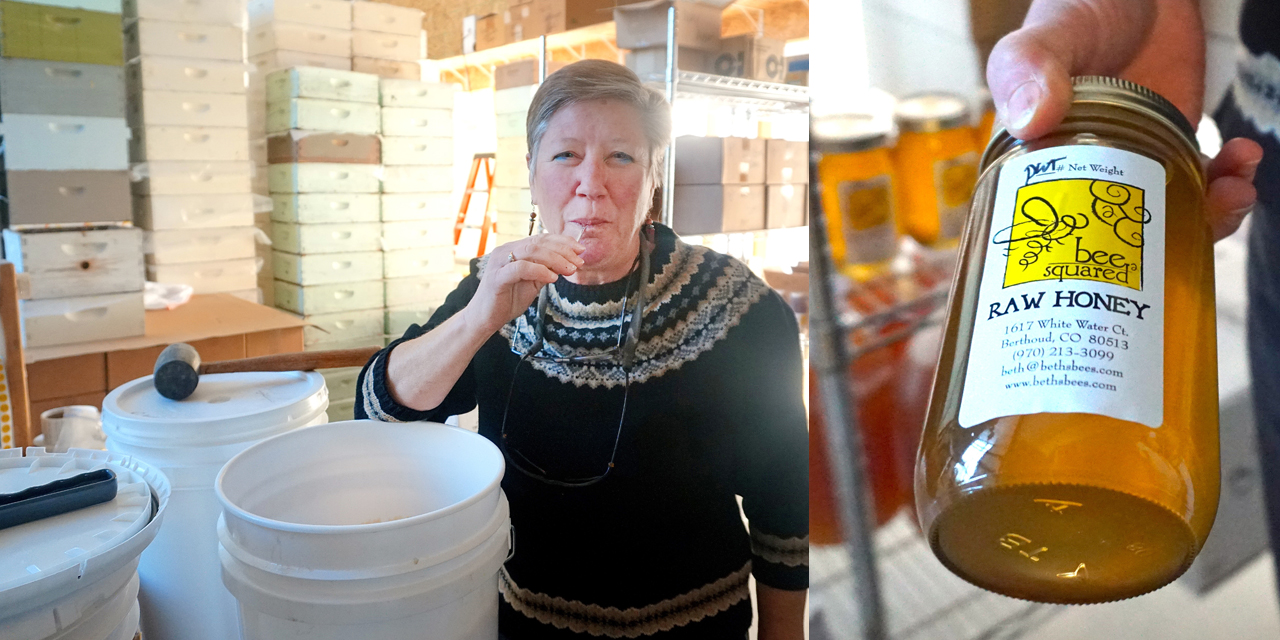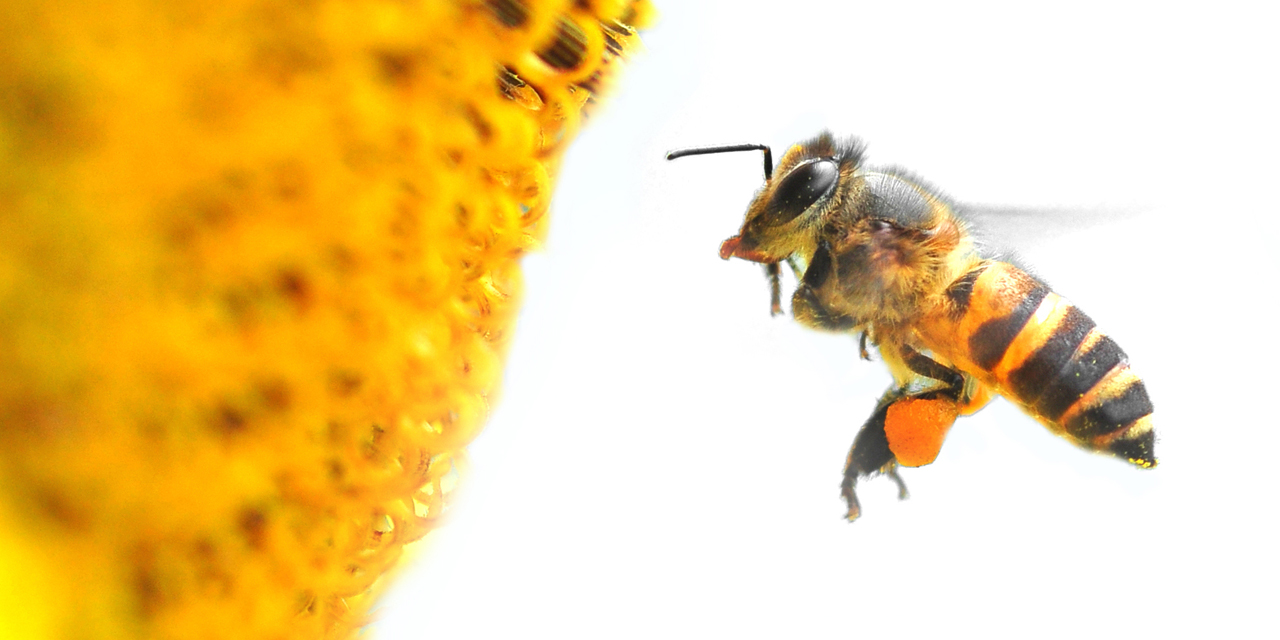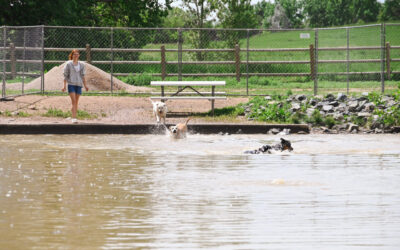By Michelle Ancell
Honeybees inhabit a complex world marked by constant activity. Beekeepers like Beth Conrey are concerned with natural and man-made threats to these amazing insects.
Life for people today is often a frenzy of constant motion, driving back and forth to work and home, responding to buzzing phones and trying to keep life under control. It’s easy to get lost in the day-to-day and forget about nature’s own miraculous creatures, their harried lives, social structure, reproduction and threats.
One of nature’s best examples of this flow is the honeybee, which operates at its own frantic pace, pollinating flowers and buzzing back to the hive with nectar. Beth Conrey, vice president of the Boulder County Beekeepers’ Association, will speak next month about honeybees’ physiology and social structure at her Bees 101 talk at the Loveland Museum as part of a comprehensive bee exhibit and program.

Beth Conrey, owner of Berthoud-based Bee Squared Apiaries, samples honey sold at her store, the Honey House. The Honey House sells products sourced from bees in three Northern Colorado counties.
As owner of Berthoud-based Bee Squared Apiaries, Conrey wants us to pause to consider the complex world of honeybees, their value to the environment, and the natural and man-made threats to the insects.
A no-nonsense woman, Conrey drives her pickup truck throughout Northern Colorado where she tends to more than 100 beehives. She lifts the lid of the hives to determine if the bees are active and numerous.
“Forward progress. I just want forward progress,” she said.
What does forward progress look like? During the spring and summer, Conrey watches to see if the bees are foraging. Within the hive, are the bees producing? Is there fresh, white comb on the frames? Are they reproducing?
“A good day is when it’s all just lifting lids,” she said. “I open the lid, look inside to make sure the hive is progressing. Does it look healthy? If I see that it is, then I move on to the next one.”
When the bees are healthy, the frames of the hives abound with wax-capped cells, trapping sweet honey inside. Conrey transports the frames back to her home in Berthoud for production. On the back of her house, west-facing windows frame the foothills of the Rocky Mountains, as well as her land, two beehives, a couple of dogs and the Honey House.
Like a hive, the Honey House is a hub of activity for Conrey and her workers. It was designed by her sister and even won an award from the American Institute of Architecture. Inside this immaculate facility, Conrey, her husband and their crew use heated knives to scrape the caps of beeswax off of the frames, then place the frames into an extractor to harvest the honey.
The results of these efforts—the bees’ and Conrey’s—are buckets and jars full of the sweet, beautiful golden honey. The Bee Squared operation also produces candles from the wax, natural soaps, honey in the comb and lip balm. Profit from the sale of these products supports bee and pollinator issues, Conrey said.
That’s the fun and rewarding enterprise that can blossom with healthy bees and hives, brimming and dripping with life.
Unfortunately, bees and their hives aren’t always healthy. Some just die. Sometimes when Conrey is lifting lids she’ll smell a foul odor, notice fewer bees, no bees, dead bees or no queen—all bad signs.
A 2017 survey by the Department of Agriculture’s Animal Plant Health Inspection Service listed several threats to bees: pesticides, infectious disease and pests, and the loss of habitat and habitat diversity due to increased urbanization.
Conrey tries to protect against the disease and pests. One major threat is the Varroa mite, an external parasitic mite that attacks honeybees. Another, much larger threat, are bears. This past year, a bear and its cub wrecked a hive in Conrey’s yard. Boxes were broken and scattered on the ground, the brood scooped out and eaten, and the honey ground into the dirt.
“It’s not the honey the bears like,” Conrey said. “It’s the brood.”
But of all the threats, pesticides are the worst, Conrey said. When they come in contact with a hive, they can immediately kill bees or slowly disable the whole hive.
“Pesticide exposure results in the compromised health of the hive or to the queen,” Conrey said. “Which typically means a longer, slower demise of the hive.”
In 2017, the Environmental Protection Agency approved the Policy to Mitigate Acute Risk to Bees from Pesticide Products to reduce the negative impacts of pesticides. But bee people, like Conrey, aren’t convinced it’s enough. In fact, it doesn’t extend to Conrey’s practice. It only covers bees that are under contract to provide pollination services.
Because, despite the pretty labels for the honey, despite the award-winning Honey House, and despite Conrey’s 20 years of experience, this winter she discovered that most of her hives in town and out east are dead. These same hives were healthy and plentiful last summer.
What happened? It’s enough to bring tears to Conrey’s eyes. It is the threats she talks about. There are so many variables, the mites, viruses and pesticides, that weaken bees.
And it’s not just Conrey’s hives. Bees have been on the decline for decades. From April 2016 to April 2017 a survey of 5,000 beekeepers conducted by the Bee Informed Partnership and the Apiary Inspectors of America reported a 33 percent decline in colonies.
“A healthy bee population is related to our ecosystem biodiversity and worldwide food production,” she said. “As the species at the top of the food pyramid, we should be worried.”
And ultimately that’s why she gives talks like Bees 101. That is why she shares her passion and knowledge, hoping some folks in the audience might be inspired to plant flowers and shrubs that bees like, such as morning glories or lilacs, and to quit using pesticides.
Beth Conrey will deliver her Bees 101 talk from 6–8 p.m., April 13, at the Loveland Museum, 503 N. Lincoln Ave.
Freelance writer Michelle Ancell, a Colorado native, works as a journalism instructor at Colorado State University. To comment on this article, send an email to letters@nocostyle.com.






